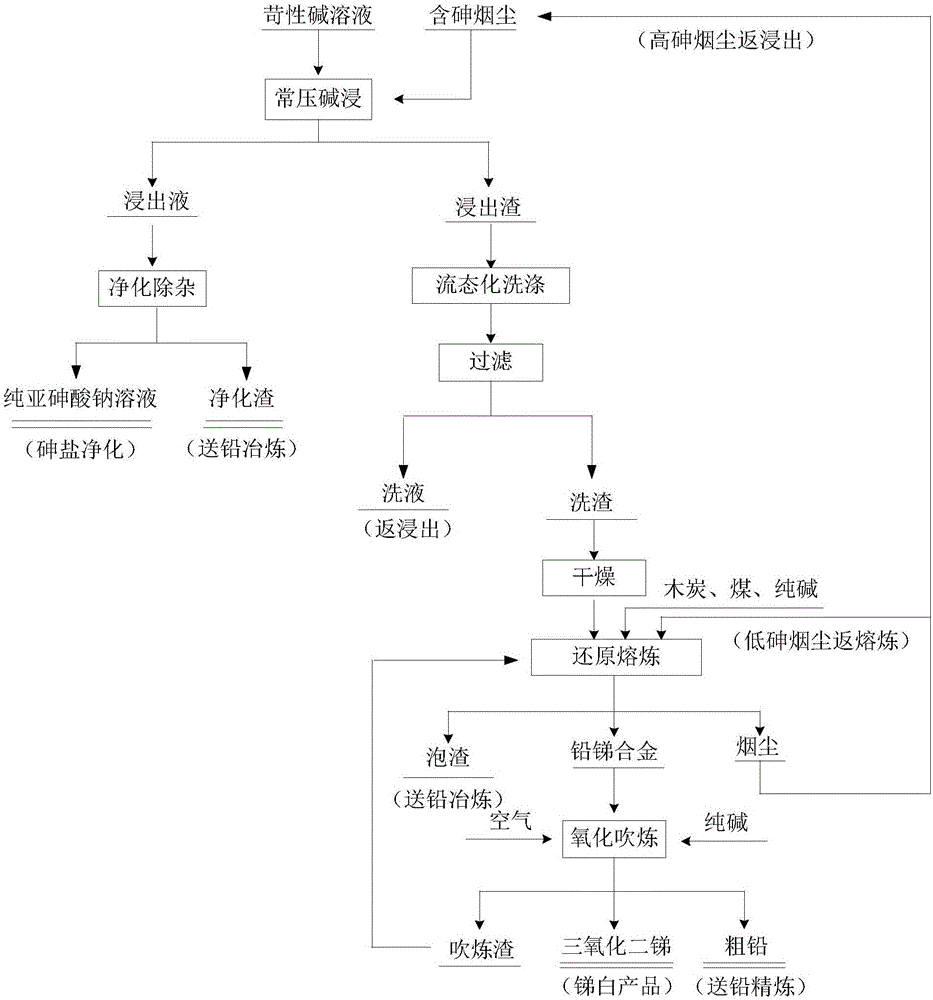Comprehensive utilization method of arsenic-containing materials
A material, arsenic fume technology, applied in the field of metallurgy, to achieve the effect of strong operability, high resource utilization, and resource utilization
- Summary
- Abstract
- Description
- Claims
- Application Information
AI Technical Summary
Problems solved by technology
Method used
Image
Examples
Embodiment 1
[0042] Taking arsenic-containing soot from a lead-zinc smelter in China as an example, it includes the following main components in terms of mass percentage: Pb 5.26%, As 39.65%, Sn 0.5%, Sb 29.36%, Zn 0.12%, Se 0.04%.
[0043] Weigh a certain mass of the high arsenic and antimony fumes in the reaction kettle, according to the liquid-solid volume mass ratio of 10:1 (ml:g), the stirring speed is 700r / min, the NaOH concentration is 1mol / L, the leaching temperature is 80°C, and the leaching time is 2h. Carry out leaching experiments. After the leaching is finished: remove the slurry and filter and separate; measure the arsenic leaching rate to 72.36%. The concentration of each element in the leach solution is Pb 86.00ppm, Se 1.80ppm, Zn 20.00ppm, Sb 1.36g / L, As 28.69g / L.
[0044] The leaching solution was passed through SO at room temperature 2 Gas reduction, reducing agent SO 2 The amount added is twice the theoretical amount required to reduce all the arsenic ions and telluri...
Embodiment 2
[0049] Taking arsenic-containing soot from a lead-zinc smelter in China as an example, it includes the following main components in terms of mass percentage: Pb 10.39%, As 34.59%, Sn 1.45%, Sb 20.54%, Zn 0.11%, Se 0.24%.
[0050] Weigh a certain mass of the high arsenic and antimony fumes in the reaction kettle, according to the liquid-solid volume mass ratio of 10:1 (ml:g), the stirring speed is 700r / min, the NaOH concentration is 3mol / L, the leaching temperature is 50°C, and the leaching time is 4h. Carry out leaching experiments. After the leaching, the slurry was removed and separated by filtration; the arsenic leaching rate was measured to be 52.06%. The concentration of each element in the leach solution was Pb 87ppm, Se 0.52ppm, Zn71ppm, Sb 1.24g / L, As 18.01g / L.
[0051] The leaching solution was passed through SO at room temperature 2 Gas reduction, reducing agent SO 2 The amount added is twice the theoretical amount required to reduce all the arsenic ions and tellur...
Embodiment 3
[0056] Taking arsenic-containing soot from a lead-zinc smelter in China as an example, it includes the following main components in terms of mass percentage: Pb 19.57%, As 24.26%, Sn 1.47%, Sb 30.45%, Zn 0.16%, Se 0.21%.
[0057] Weigh a certain mass of the high arsenic and antimony fumes in the reaction kettle, according to the liquid-solid volume mass ratio 5:1 (ml:g), stirring speed 1000r / min, NaOH concentration 1mol / L, leaching temperature 30 ℃, leaching time 2h Carry out leaching experiments. After leaching, the slurry was removed and separated by filtration; the arsenic leaching rate was measured to be 42.26%, and the concentrations of elements in the leach solution were Pb 124ppm, Se 0.67ppm, Zn 107ppm, Sb 2.02g / L, and As 10.25g / L.
[0058] The leaching solution was passed through SO at room temperature 2 For gas reduction, the amount of reducing agent added is twice the theoretical amount required to reduce all the arsenic ions and tellurium ions in the leaching solut...
PUM
 Login to View More
Login to View More Abstract
Description
Claims
Application Information
 Login to View More
Login to View More - R&D
- Intellectual Property
- Life Sciences
- Materials
- Tech Scout
- Unparalleled Data Quality
- Higher Quality Content
- 60% Fewer Hallucinations
Browse by: Latest US Patents, China's latest patents, Technical Efficacy Thesaurus, Application Domain, Technology Topic, Popular Technical Reports.
© 2025 PatSnap. All rights reserved.Legal|Privacy policy|Modern Slavery Act Transparency Statement|Sitemap|About US| Contact US: help@patsnap.com

